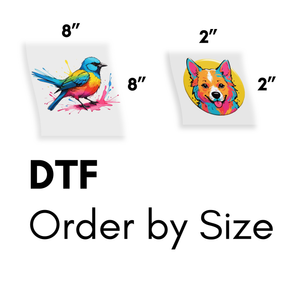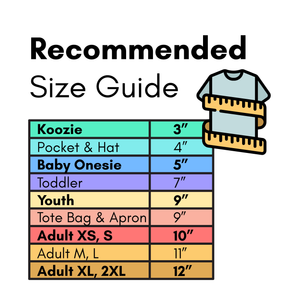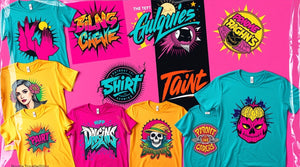🎨 DTF Transfer vs Sublimation: Which One Wins in the Custom Printing Game?
When it comes to garment decoration and custom printing, two popular methods dominate the scene: DTF transfer vs sublimation. Both techniques offer unique advantages, but choosing the right one can significantly affect your final product.
In this guide, we’ll break down the pros, cons, and ideal use cases of DTF and sublimation. Whether you're starting a custom T-shirt business or scaling your print shop, understanding these methods will help you make an informed decision. 💡👕
🧾 What is DTF Transfer?
DTF (Direct to Film) is a printing method where designs are printed onto a film and then transferred to a garment using a heat press and adhesive powder. Unlike sublimation, DTF works on a wide range of fabrics — including cotton, polyester, blends, and even leather.
👉 Visit our DTF Transfer collection to explore high-quality transfer sheets for all your printing needs.
✅ Benefits of DTF Transfers:
-
Works on light and dark fabrics 🖤
-
Compatible with multiple fabric types (cotton, polyester, etc.)
-
Vivid, long-lasting colors 🎨
-
No weeding required
-
Lower barrier to entry in terms of equipment
🖨️ What is Sublimation?
Sublimation printing uses heat to transfer dye onto materials like polyester fabrics or specially coated items. The dye turns into gas and embeds itself into the material — resulting in a soft, permanent, and vibrant print.
📚 Learn more about sublimation printing from the official Wikipedia page.
✅ Benefits of Sublimation:
-
Extremely durable prints 💪
-
No peeling or cracking
-
Ideal for sportswear and polyester fabrics
-
Great for photo-realistic designs 🖼️
🔍 DTF Transfer vs Sublimation: Side-by-Side Comparison
| Feature |
DTF Transfer |
Sublimation |
| Fabric Compatibility |
Cotton, polyester, blends, leather |
Mostly polyester or coated surfaces |
| Color Vibrancy |
Excellent on light/dark garments 🎨 |
Excellent on light-colored garments |
| Durability |
High, especially with quality powder |
Extremely durable, embedded dye |
| Equipment Cost |
Moderate |
Moderate to high |
| Start-Up Simplicity |
Easier for beginners |
Slightly complex setup |
| Wash Resistance |
Very good 🧼 |
Excellent 💧 |
| Eco-Friendly |
Depends on inks and films |
Often more eco-conscious ♻️ |
🧵 Which One Should You Choose?
🎯 Choose DTF Transfers If:
-
You want to print on various fabric types including cotton
-
You need strong color opacity on dark garments
-
You’re just starting your custom printing business
-
You want to print intricate or full-color designs with no weeding
👉 Check out the DTF Transfer Now Collection to see what's possible!
🎯 Choose Sublimation If:
-
You focus on polyester garments or promotional items
-
You prioritize soft, embedded prints with high durability
-
You're printing mostly light-colored items
-
You want photo-quality designs that won’t crack or fade
🌱 Environmental Considerations
Sublimation is often considered more eco-friendly due to waterless printing and lower waste. However, many DTF manufacturers are now offering eco-solvent inks and biodegradable films, making DTF increasingly sustainable. 🌍
🛠️ Setup and Maintenance
-
DTF printers require regular cleaning and care, especially for the printheads. Learn more about printer cleaning tips to ensure smooth operation.
-
Sublimation printers need heat-resistant blanks and strict humidity control to avoid ghosting and color shifts.
💰 Cost Breakdown
-
DTF setup includes the printer, film, powder, and a heat press. It’s affordable for small businesses and great for bulk runs.
-
Sublimation setup requires a sublimation printer, heat press, and compatible materials. Higher-quality setups can be costly, but long-term costs are low due to dye efficiency.
🛍️ Product Range and Limitations
can be used on hats, hoodies, bags, and more — making them perfect for e-commerce sellers and merch designers. 💼
Sublimation is ideal for mugs, puzzles, mousepads, and performance fabrics — but limited to light polyester materials.
🌟 Conclusion: DTF Transfer vs Sublimation
Both DTF and sublimation have their place in the printing world. If you need flexibility and rich color on various fabrics, DTF transfer is your go-to. If you want ultra-durable, dye-embedded prints for polyester, sublimation might be your best choice.
Still unsure? Explore both methods with DTF Print House and level up your printing game today! 🚀

 Vendor:DTF Print House
Vendor:DTF Print House Vendor:DTF Print House
Vendor:DTF Print House

